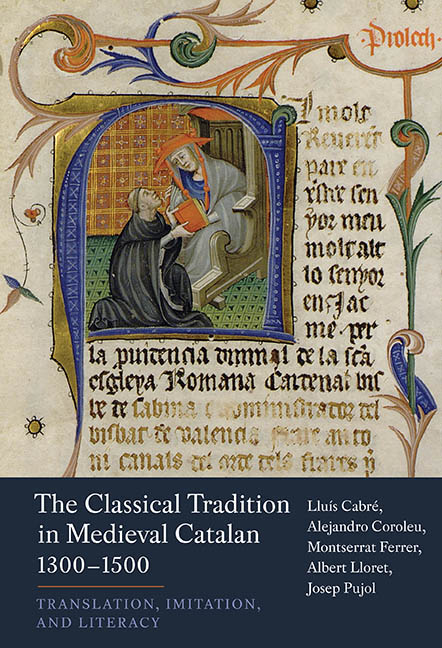Book contents
- Frontmatter
- Contents
- List of Maps
- Preface
- List of Abbreviations
- Part I The Classical Tradition in Medieval Catalan
- 1 Historical Background
- 2 Literacy: Translations and Royal Patronage
- 3 Imitation: The Classical Tradition in the Works of Five Major Authors
- 4 Printing: Humanism and the Renaissance
- Part II Catalogue of Translations to 1500
- Appendix 1 Italian Renaissance: Printed Editions, 1473–1535
- Appendix 2 Rulers of the Crown of Aragon, 1137–1516
- Bibliography
- Index of Manuscripts
- Index
1 - Historical Background
from Part I - The Classical Tradition in Medieval Catalan
Published online by Cambridge University Press: 03 July 2019
- Frontmatter
- Contents
- List of Maps
- Preface
- List of Abbreviations
- Part I The Classical Tradition in Medieval Catalan
- 1 Historical Background
- 2 Literacy: Translations and Royal Patronage
- 3 Imitation: The Classical Tradition in the Works of Five Major Authors
- 4 Printing: Humanism and the Renaissance
- Part II Catalogue of Translations to 1500
- Appendix 1 Italian Renaissance: Printed Editions, 1473–1535
- Appendix 2 Rulers of the Crown of Aragon, 1137–1516
- Bibliography
- Index of Manuscripts
- Index
Summary
The Catalan-Speaking Lands, between the North and the South
The northeastern reaches of modern-day Catalonia have long been a transitional frontier land, a strategic crossroads, the gateway between the Iberian Peninsula and the rest of the continent. From pre-Roman times to the present day, the population of this region has been nourished by migration, both from the north and from the south. Its culture has also been shaped by its access to the Mediterranean, since the golden age of Phoenician trade and the establishment of the Greek colonies of Emporion around 600 bc and later Rhode (modern-day Empúries and Roses), and in particular since the start of the Roman conquest of the Peninsula in 218 BC, when Gnaeus Cornelius Scipio landed at Empúries to cut off Hannibal's supply lines during the Second Punic War. Marching southwards, Scipio established a camp at Tarraco (Tarragona), which in due course became a colony, and then, in Augustus's time, the capital of a Roman province which included several towns, still important urban centres in presentday Catalonia: Gerunda (Girona), Iluro (Mataró), Baetulo (Badalona), Barcino (Barcelona), Ausa (Vic), Ilerda (Lleida), and Dertosa (Tortosa) (see Map 1). Some of these towns became bishoprics and, with the institutionalization of Christianity in the early fourth century, Tarraco the archbishopric. The profound Romanization and Christianization of this region persisted during the Visigothic period until the early eighth century. The subsequent Islamic conquest of the Peninsula lasted in the northeastern part of what would become Catalonia for less than a century. In these lands, Latin gave way to Catalan, a Romance language closely related to Occitan – the language spoken from Limoges to the Pyrenees and from Bordeaux to Nice in the southern half of modern-day France. From then until the fifteenth century, Catalan evolved naturally and its written form matured as a vernacular language, with Latin remaining the high-status language of culture.
Catalonia's strategic location has played a key role in its history. Over the centuries that location explains the settlement of new populations, the frequent incursions, the northward emigrations of the native population, and the industrial and commercial activity of a region that is well connected, but has limited natural resources.
- Type
- Chapter
- Information
- The Classical Tradition in Medieval Catalan, 1300–1500Translation, Imitation, And Literacy, pp. 3 - 28Publisher: Boydell & BrewerPrint publication year: 2018



